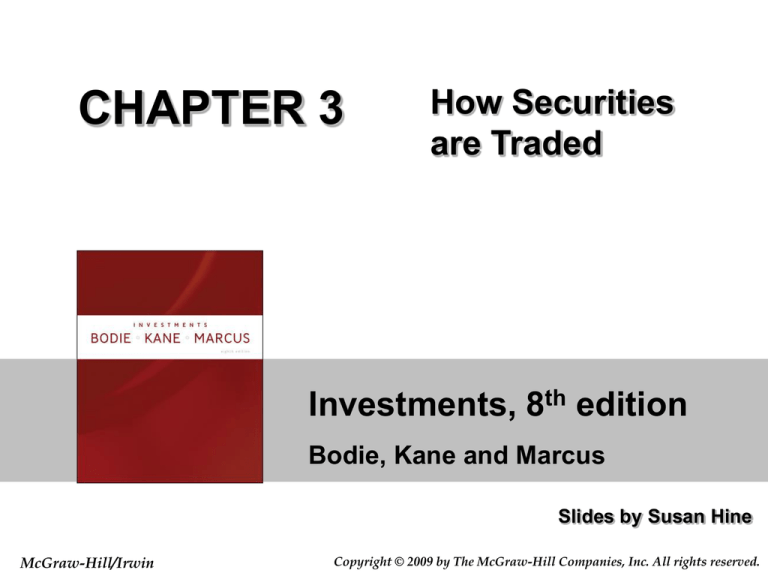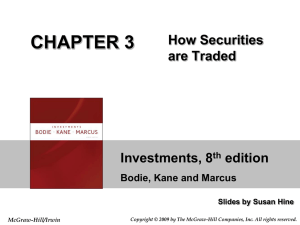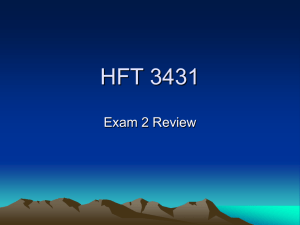
CHAPTER 3
How Securities
are Traded
Investments, 8th edition
Bodie, Kane and Marcus
Slides by Susan Hine
McGraw-Hill/Irwin
Copyright © 2009 by The McGraw-Hill Companies, Inc. All rights reserved.
How Firms Issue Securities
• Primary
– New issue
– Key factor: issuer receives the proceeds
from the sale
• Secondary
– Existing owner sells to another party
– Issuing firm doesn’t receive proceeds
and is not directly involved
3-2
How Firms Issue Securities Continued
• Investment Banking
• Shelf Registration
• Private Placements
• Initial Public Offerings (IPOs)
3-3
Investment Banking
• Underwritten: firm commitment on proceeds
to the issuing firm
• Red herring
• Prospectus
3-4
Figure 3.1 Relationship Among a Firm Issuing
Securities, the Underwriters and the Public
3-5
Shelf Registrations
• SEC Rule 415
• Introduced in 1982
• Ready to be issued – on the shelf
3-6
Private Placements
• Sale to a limited number of sophisticated
investors not requiring the protection of
registration
• Allowed under Rule 144A
• Dominated by institutions
• Very active market for debt securities
• Not active for stock offerings
3-7
Initial Public Offerings
• Process
– Road shows
– Bookbuilding
• Underpricing
– Post sale returns
– Cost to the issuing firm
3-8
Figure 3.2 Average Initial Returns for
IPOs in Various Countries
3-9
Figure 3.3 Long-term Relative
Performance of Initial Public Offerings
3-10
How Securities are Traded
• Types of Markets
– Direct search
• Least organized
– Brokered
• Trading in a good is active
– Dealer
• Trading in a particular type of asset
increases
– Auction
• Most integrated
3-11
Types of Orders
• Market—executed immediately
– Bid Price
– Ask Price
• Price-contingent
– Investors specify prices
– Stop orders
3-12
Figure 3.4 The Limit Order Book for Intel
on the Archipelago Market,
January 19, 2007
3-13
Figure 3.5 Price-Contingent Orders
3-14
Trading Mechanisms
• Dealer markets
• Electronic communication networks (ECNs)
• Specialists markets
3-15
U.S. Security Markets
• Nasdaq and NYSE have evolved in response
to new information technology
• Both have increased their commitment to
automated electronic trading
3-16
Nasdaq
• National Market System
• Nasdaq Small Cap Market
• Levels of subscribers
– Level 1 – inside quotes
– Level 2 – receives all quotes but they can’t
enter quotes
– Level 3 – dealers making markets
3-17
Table 3.1 Partial Requirements for Listing
on NASDAQ Markets
3-18
New York Stock Exchange
• Member functions
– Commission brokers
– Floor brokers
– Specialists
• Block houses
• SuperDot
3-19
Table 3.2 Some Initial Listing
Requirements for the NYSE
3-20
Table 3.3 Block Transactions on the
New York Stock Exchange
3-21
Other Systems
• Electronic Communication Networks
– Private computer networks that directly link
buyers with sellers
• National Market System
– Securities Act of Amendments of 1975
• Bond Trading
– Automated Bond System (ABS)
3-22
Market Structure in Other Countries
• London - predominately electronic trading
• Euronext – market formed by combination of
the Paris, Amsterdam and Brussels
exchanges
• Tokyo Stock Exchange
• Globalization and consolidation of stock
markets
3-23
Figure 3.6 Market Capitalization of Major
World Stock Exchanges, 2007
3-24
Trading Costs
• Commission: fee paid to broker for making
the transaction
• Spread: cost of trading with dealer
– Bid: price dealer will buy from you
– Ask: price dealer will sell to you
– Spread: ask - bid
• Combination: on some trades both are paid
3-25
Buying on Margin
• Using only a portion of the proceeds for an
investment
• Borrow remaining component
• Margin arrangements differ for stocks and
futures
3-26
Stock Margin Trading
• Margin is currently 50%; you can borrow up to
50% of the stock value
– Set by the Fed
• Maintenance margin: minimum amount equity
in trading can be before additional funds must
be put into the account
• Margin call: notification from broker that you
must put up additional funds
3-27
Margin Trading - Initial Conditions
Example 3.1
X Corp
$100
60%
Initial Margin
40%
Maintenance Margin
100
Shares Purchased
Initial Position
Stock $10,000 Borrowed
Equity
$4,000
$6,000
3-28
Margin Trading - Maintenance Margin
Example 3.1
Stock price falls to $70 per share
New Position
Stock $7,000 Borrowed $4,000
Equity
$3,000
Margin% = $3,000/$7,000 = 43%
3-29
Margin Trading - Margin Call Example 3.2
How far can the stock price fall before a
margin call?
(100P - $4,000)* / 100P = 30%
P = $57.14
* 100P - Amt Borrowed = Equity
3-30
Table 3.4 Illustration of Buying Stock
on Margin
3-31
Short Sales
• Purpose: to profit from a decline in the price
of a stock or security
• Mechanics
– Borrow stock through a dealer
– Sell it and deposit proceeds and margin in
an account
– Closing out the position: buy the stock
and return to the party from which is was
borrowed
3-32
Short Sale – Initial Conditions Example 3.3
Dot Bomb
50%
30%
$100
1,000 Shares
Initial Margin
Maintenance Margin
Initial Price
Sale Proceeds $100,000
Margin & Equity 50,000
Stock Owed
100,000
3-33
Short Sale - Maintenance Margin
Stock Price Rises to $110
Sale Proceeds
Initial Margin
Stock Owed
Net Equity
Margin % (4000/11,000)
$10,000
5,000
11,000
4,000
36%
3-34
Short Sale - Margin Call
How much can the stock price rise before a
margin call?
($150,000* - 1000P) / (100P) = 30%
P = $115.38
* Initial margin plus sale proceeds
3-35
Regulation of Securities Markets
• Major regulations
– Securities Act of 1933
– Securities Act of 1934
– Securities Investor Protection Act of 1970
• Self-Regulation
– Stock markets are largely self-regulating
3-36
Regulation Securities Markets Continued
• Regulatory Responses to Recent Scandals
– Public Company Accounting Oversight
Board
– Financial experts to serve on audit
committees of boards of directors
– CEOs and CFOs personally certify firms’
financial reports
– Boards must have independent directors
– Sarbanes-Oxley Act
3-37
Circuit Breakers
• Trading halts
• Collars
3-38
Insider Trading
• Officers, directors, major stockholders must
report all transactions in firm’s stock
• Insiders do exploit their knowledge
• Leakage of useful information to some
traders
3-39









